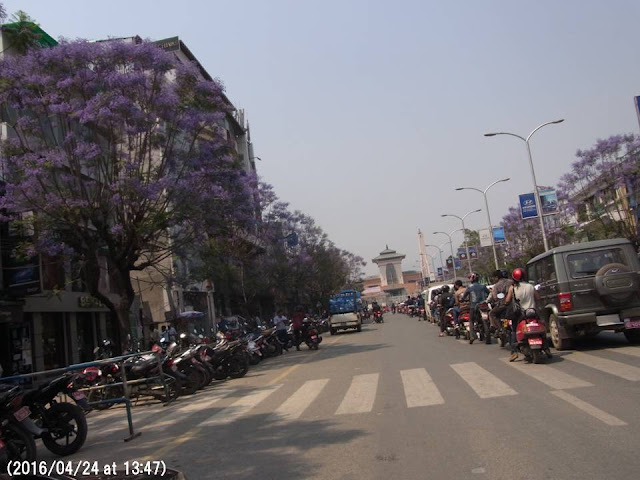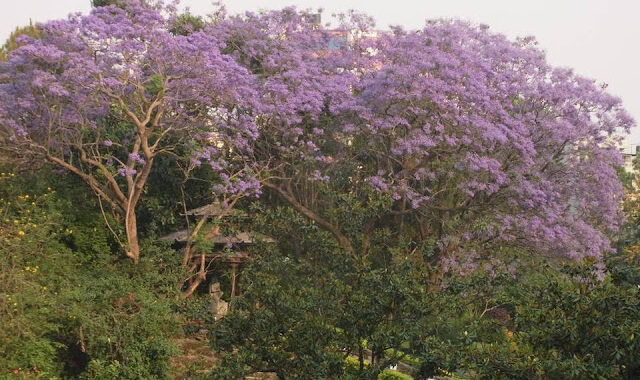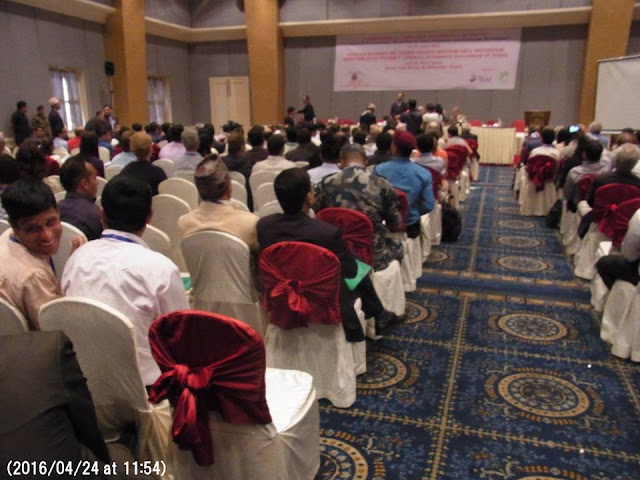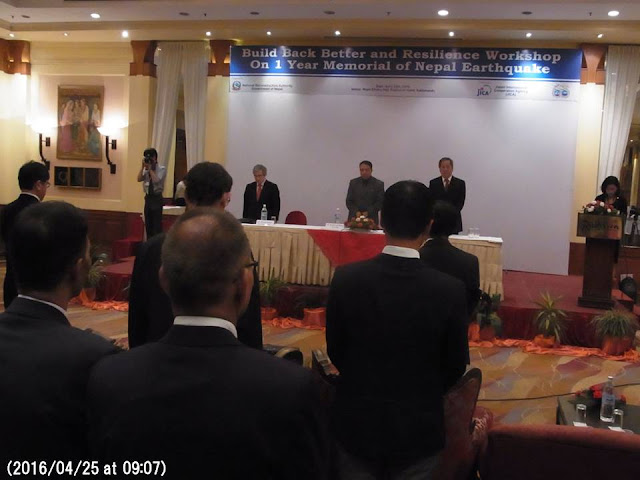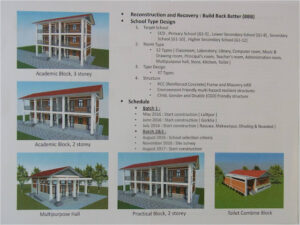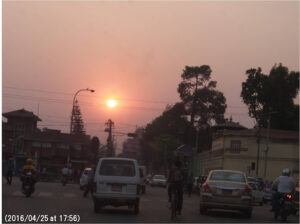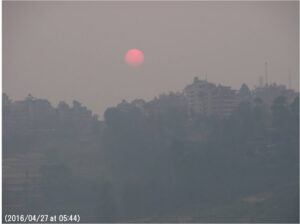2016年ネパール通信4 二つの会議
はじめに
会議1)International Workshop on Gorkha Earthquake, Nepal(4月24日~25日)
会議2)Nepal Earthquake one year memorial Build Back Better and Resilience Workshop(4月25日)
カトマンズの街は大気・水質汚染やゴミ・交通渋滞などの環境問題をかかえていますが、温かくなる4月中旬は紫色の木の花、ジャカランダで彩られます (写真1,2)。ジャカランダの影響でしょうか、街の広告や女性のサリーまでもが、ポカラのカエンジュ*の赤色に比較すると、カトマンズでは紫色が好まれ るように感じます。ポカラはより熱帯的で、朱に近い赤色のカエンジュが街を彩っているのと対照的です。
*2015年ネパール春調査(10)ポカラ報告
ショウガと火炎樹の花
Department of Mines and Geologyが主催した会議1)International Workshop on Gorkha Earthquake, Nepal(4月24日~25日)はYak&Yeti ホテルで開催されました
かつてのラナ王朝を思わすような歴史的建物が会場で、会議の冒頭に、昨年の地震で被害にあわれた方々への1分間の黙と うが行われました(写真4)
会議1)の内容とスケジュールをみますと、地球物理的、地質・地形学的な手法で「2015年ネパール地震」の特徴を明らかにする研究成果が多く発表されました。ぼく自身のは発表「Himalayan Earthquake Museum 」* は、最後の社会学的な視点からの研究グループの中で、行いました。いかにさまざまな手法で地震の特徴を沖らかににしても、残念がら、地震を防ぐことはでき ないのですから、せめて地震被害を少なくする手立てが現実的に必要であることを、かつてポカラの国際山岳博物館で学芸員をした経験から、「ヒマラヤ地震博 物館」でも若い学生たちにヒマラヤの地震について知ってもらい、被害を軽減する手立てを考えてもらうことが必要であることを発表したところ、できるだけ早 く、カトマンズにヒマラヤ地震博物館を、また雪崩災害にあったランタン地域にヒマラヤ災害情報センターをつくる構想に参加者が興味をくれました。できれ ば、カトマンズのランドマーク・タワーで破壊されたビムセン・タワーを保存し、その隣にヒマラヤ地震博物館を建設する構想にも大方の賛同が得られたので、 この構想の推進に心強さを感じました。
(資料1) 会議1)の内容とスケジュール
http://www.seismonepal.gov.np/index.php?listId=189Day One (24 April 2016)
Session I
Seismo‐tectonics and Gorkha Earthquake(Implications for seismic hazard)Authors (Speaker in bold)
09:00 − 09:25 (Key note) Paul Tapponnier
09:25 − 09:50 (Key note) Negligible afterslip following the Gorkha earthquake: Implications for future Himalayan earthquakes Roger Bilham
09:50 − 10:15 (Key note) Seismic slip deficit along Nepal Himalayas: implications for seismic hazard Laurent Bollinger
10:15 − 10:30 The Himalayan Seismogenic Zone: The Case for an Integrated Multinational Initiative Larry Brown
10:30 − 10:45 Shortening rates across frontal folds and seismotectonic model along the Himalayan arc of Nepal Jérôme Lave
10:45 − 11:00 Structural segmentation of the Main Himalayan Thrust controlled the 2015 Mw 7.8 Gorkha earthquake rupture in Nepal Rafael Almeida
11:00 − 14:00 INAGURATION + LUNCH
Source Mechanism Of Gorkha Earthquake (Better Understanding on Himalayan Earthquakes)
14:00 − 14:25 (Key note) What happened before, during and after the 2015, Mw 7.8 Gorkha earthquake, what to expect next Jean‐Philippe Avouac
14:25 − 14:40 Source model and broadband ground shaking simulation of the 2015 Gorkha (Nepal) Earthquake sequence Shengji Wei
14:40 − 14:55 The 2015 April 25 Gorkha (Nepal) Earthquake and itsAftershocks: Implications for lateral heterogeneity on the Main Himalayan Thrust Supriyo Mitra
14:55 − 15:10 Source Modeling of the 2015 Mw 7.8 Nepal (Gorkha) Earthquake Sequence Implications for Geodynamics and Earthquake Hazards Daniel McNamara
15:10 15:30 TEA BREAK
Monitoring and Intensity of Gorkha Earthquake (Observation and experience )
15:30 − 15:50 (Special paper) The aftershock sequence of the 2015 April 25 Gorkha earthquake Lok Bijaya Adhikari
15:50 − 16:05 John Nabelek
16:05 − 16:20 Effects of the 25 April 2015 Gorkha (Nepal) Earthquake in Bangladesh A. K. M. Khorshed Alam
16:20 − 16:35 The role in the Gorkha 2015 earthquake Mw7.8, of the broadband seismograph to the Pyramid of the EvK2Cnr Franco Pettenati
16:35 − 16:50 Coseismic and early postseismic deformation due to the 25 April 2015, Mw 7.8 Gorkha, Nepal, earthquake from InSAR and GPS measurements Sreejith KM
16:50 − 17:05 Translation and stopping phase of the Gorkha rupture David Mencin
17:05− 17:20 Preliminary Result on Intensity Survey of Gorkha Earthquake Based on Field Questionnaire Survey Method Sujan Raj Adhikari Ground Motion of Gorkha Earthquake (Implications for Seismic Hazard)Day Two (25 April 2016)
09:00 − 09:25 (Key note) Factors Controlling Regional and Near‐field Ground Motions During the 2015 Gorkha, Nepal, earthquake Susan Hough
09:25 − 09:45 (Special paper) Non‐linear response of kathmandu sediments basin during 2015Gorkha earthquake sequence Sudhir Rajaure
09:45 − 10:00 Widespread ground motion distribution caused by rupture directivity during the 2015 Gorkha, Nepal earthquake Kazuki Koketsu
10:00 − 10:15 Detection of nonlinear site response using the main shock and its aftershocks of the 2015 Gorkha, Nepal Earthquake recorded at the DMG site of the Kathmandu Valley, Nepal. Mukunda Bhattarai
10:15 − 10:30 On systematic pattern of ground deformation in Kathmandu valley during 2015 Gorkha Earthquake Subesh Ghimire
10:30 − 10:45 Cyclic Geotechnical Characterization of Soils from Kathmandu Valley with Reference to 2015 Gorkha Seismic Sequence Deepak Chamlagain
10:45 − 11:00 A Seismic Hazard Assessment for the Kathmandu Valley Fumio Kaneko
11:00 − 11:15 Earthquake Induced Landslides and Gorkha Earthquake ( Understanding on Landscape Response )
11:15 − 11:40 (Key note) Investigation of Coseismic Landslides and Associated Newmark Displacements in the Bhote Koshi Watershed of Central Nepal by the 25 April 2015 Gorkha Earthquake Megh Raj Dhital
11:40 − 11:55 Landscape response to the Mw 7.8 Gorkha Earthquake Christoph Sens‐Schönfelder
11:55 − 12:10 Earthquake‐induced landslides in Nepal after Gorkha earthquake and Sikkim‐Nepal Border Earthquake Ranjan Kumar Dahal
12:10 − 12:25 Landslide damming hazard in Central Nepal after the 25 April 2015 Gorkha Earthquake Moti Rijal
12:25 − 12:40 Rapid Geological Assessment of 2015 Gorkha Earthquake, an Approach by DMG Susmita Bhandari
12:40− 12:55 Landslide hazard zonation mapping in Post‐Earthquake scenario in Gorkha District Him Lal Shrestha
12:55 − 13:45 LUNCH BREAK
14:15 − 14:35 (Special paper) Falality index of 1934 M8.3 Bihar‐Nepal Earthquake and comparision with 2015 Gorkha Earthquake Somanath Sapkota
14:35 − 14:50 Damage Assessment of Infrastructure by Gorkha Earthquake
Induced Landslides and Instabilities Dinesh Pathak
14:50 − 15:05 Building Damage Patterns of April 25, 2015 Gorkha Earthquake and “Baliyo Ghar Program” to support Earthquake Reconstruction. Ramesh Guragain
15:05 − 15:20 Effect of Large Earthquake on Hydropower Projects; Case Study of Upper Trishuli 3’A’ Hydroelectric Project Ambikesh Jha
15:20 − 15:35 Seismic Vulnerabilities at Household Level: A Case‐study on Barpak Victims after the Gorkha Earthquake Lulu He
15:35 − 15:55 Preparedness/Reconstruction(For Better Future )
15:55 − 16:15 (Special paper) Nepal Earthquake 2015: A Tragedy, Trigger for Change ‐ An Opportunity Basanta Shrestha
16:15 − 16:30 Impact of the Earthquake on Livelihood and its Recovery Bishnu B. Bhandari
16:30 − 16:45 Himalayan Earthquake Museum Hiroji Fushimi
16:45 − 17:00 The Gurkha Earthquake and its Implications for Future Socioeconomic, Biophysical, and Institutional Development in Nepal Durga Poudel
17:00 − 17:15 Rebuilding Nepal for Next Earthquake Badan Nyachhyon
17:15 − 17:30 Need of Green Building Concept in the upcoming reconstruction process Pragyan Bhattarai
17:30 − 18:00 TEA BREAK
13:45 − 14:15 POSTER SESSION
Authors (Presenter in bold) Topic
Roser HOSTE‐COLOMER Western Nepal seismicity recorded by a Temporary Seismic Network
Manuel Mendoza Aftershck Sequence of the 2015 Mw 7.8 Gorkha Earthquake From the NAMASTE Seismic Network: A Clearer View of Fault Geometry, Barriers, and Asperities
Sunil Poikayil Pre‐, Co‐ and Post‐ seismic crustal deformation associated to 25th April 2015, Mw 7.8 Gorkha, Nepal earthquake constrained by continuous GPS data
Anna Foster Focal Mechanisms of the 2015 Gorkha Earthquake Aftershock Sequence
Marianne S. Karplus Lithospheric structure and seismicity in Nepal from aftershocks of the M7.8 Gorkha (Nepal) Earthquake: Early results from Project NAMASTE
Manuel Mendoza Using multiple global seismic arrays to image 2015 Mw 7.8 Gorkha earthquake and its aftershock sequence from teleseismic distance
Monique Fort The April‐May 2015 earthquake sequence in the lower Khumbu‐Pharak area (Nepal): role in landslides triggering and impacts on the local communities
Hui Cao Three‐Dimensional Exhumation Process of the Greater Himalayan Complex above the Main Himalayan Thrust during the Indo‐Asian Collision
Uma Ghosh Seismic characteristics and seismic hazard assessment: Source region of the 2015 Nepal earthquake Mw 7.8 in Central Himalaya
Hotrika Joshi 2015 Nepal Earthquake Demolition Experiences
Sanjeev Regmi Effect of Gorkha earthquake in Hydropower sectors of Nepal
Narayangopal Ghimire Post Earthquake Situation in Nepal
Sudhir Rajaure Simulation of PGA using rupture and unrupture part of the Main
Himalayan Thrust during the 2015 Gorkha Earthquake
Sudan Bikash Maharjan Landslide susceptibility mapping of Gorkha Earthquake 2015 in Nepal using logistic regression model
DDR & Build Back Better Recovery, Lessons from Kobe,Hyogo
(資料2) 会議2)の内容とスケジュール
Date: Monday, April 25th, 2016Venue: Nepa Dhuku Hall, Radisson Hotel,Kathmandu08:30 09:00 Registration & Coffee/Tea/light snacks
09:00 09:05 Pay 1 minute silence for praying the victims
09:05 09:35 Opening Remarks by
– Mr. Sushil Gyewali, CEOof NRA
– Representative ofNRA Steering Committee
– His Excellency Mr.MasashiOgawa, Ambassadorof Japanto Nepal
– Mr.HiroshiKato, Vice-President of JICA
09:35 10:15 Presentation by JICA Project on Achievements and Future Prospects of JICA’s Assistance
10:15 10:30 Coffee/Tea Break
10:30 10:45 Presentation by NRA regarding reconstruction policy and accomplishment
– Mr. Ram Prasad Thapalia, Joint Secretary of NRA
10:45 11:00 Presentation by Dr. Satoru Nishikawa,Executive Director ofResearch,Japan Center for Area Development Research
11:00 11:15 Presentation by Prof.MasahikoMurata,Kansai University of International Studies
11:15 12:15 Panel Discussion and Q&A
– Mr. Purna Chandra Bhattarai, Joint Secretaryof MoFALD
– Er. Shiva Hari Sharma, Joint Secretaryof MoUD
– Mr. Ima Narayan Shrestha, Joint Secretary of DoE
– Dr. Hari Ram Parajuli,Executive Member of NRA
– Mr. Lal Bahadur Khatri, Under Secretary of MoF
– Dr. Nishikawa and Prof. Murata
Discussion Topics:“Expediting further the recovery and reconstruction”
– Human Resources
– Budgetary andFund flow
– Local level implementation
12:15 12:25 Wrap upbyJICA
12:25 12:35 Closing Remarks
地震に関する二つの会議が終了した4月25日の夕方も、カトマンズは濃いスモッグに覆われ、赤い夕陽が沈んでゆきました(写真7)が、カトマンズ郊外 の大学の戻ってみた太陽もまたスモッグの中から赤い朝日となって現れてくるのでした(写真8)。今春は昨春と違って、大気が乾燥・高温状態で汚染物質が溜 まり、3千メートル以下の下界はひどいスモッグにすっぽりと覆われ、神々座を拝むことができないのが残念です。
